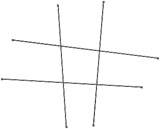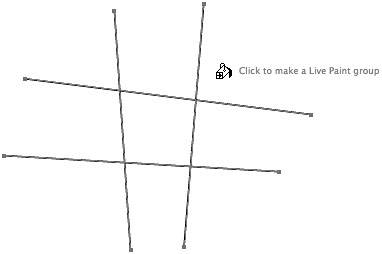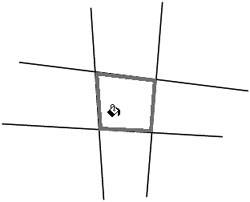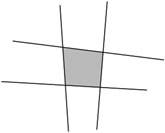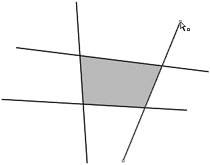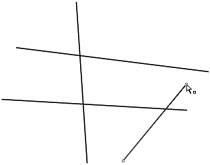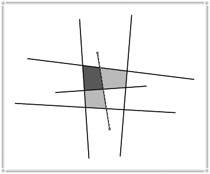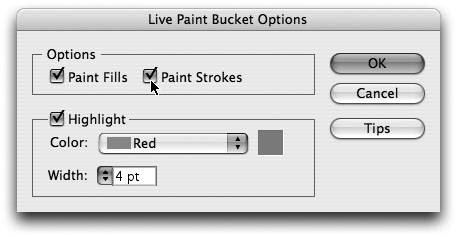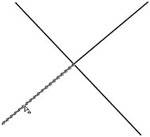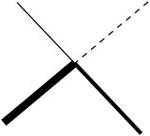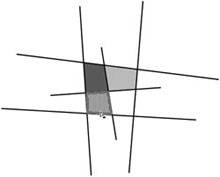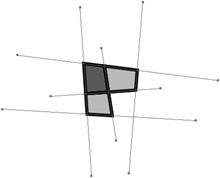Introducing the Live Paint Feature
| Although you can appreciate the power that vector graphics have to offer, you should also appreciate how easy it is to use pixel-based paint programs like Adobe Photoshop or Corel Painter to easily apply color to artwork. In a paint program, you can perform flood fills, in which you choose a color and use a paint bucketlike tool to fill areas of the illustration with color. When working with vectors, you know that you have to create distinct paths and shapes in order to apply a fill attribute to add color. This need to create distinct objects can make drawing in Illustrator seem nonintuitive, or time-consuming at best. New to Illustrator CS2, Live Paint is a feature that introduces a new concept of working with vector paths, where you can colorize vectors and edit them without having to follow the traditional vector rules that we've been covering up to this point. This new feature makes it a lot easier to draw in Illustrator. Let's take a closer look. Using Live Paint to Color PathsFirst, you'll create something using Live Paint to get a feel for what the feature is all about. Then we'll discuss how the feature works and at that point, you'll better understand how to use it in a meaningful way. Choose the Line Segment tool and draw two parallel vertical lines and two parallel horizontal lines to create a tic-tac-toe board. Don't worry if the lines or spacing aren't perfectfor this exercise, you just want to make sure the lines cross each other (Figure 4.41). Figure 4.41. Using the Line Segment tool, you can create a simple tic-tac-toe graphic. Select the four lines and choose the Live Paint Bucket tool. As you move your cursor over the four paths, the paths become highlighted (Figure 4.42). Click once to create a Live Paint group. Now, choose a fill color (a solid color, gradient, or pattern) from the Control palette and move your cursor over the center area of the tic-tac-toe board. The enclosed area in the middle becomes highlighted in red, which indicates an area that you can fill with color (Figure 4.43). Click once with the Live Paint Bucket tool to fill the highlighted area (Figure 4.44). Figure 4.42. If you have the Live Paint Bucket tool selected, Illustrator shows a tool tip to create a Live Paint group when your cursor passes over a valid selection. Figure 4.43. Illustrator's Live Paint Bucket tool highlights areas that can be filled as you mouse over them, even if the Live Paint groups aren't selected. Figure 4.44. With one click of the Live Paint Bucket tool, you can fill areas that appear to be enclosed, even though there is an actual vector object there. The resulting behavior is very Photoshopesqueyou've filled an area that is enclosed on all sides, but you didn't fill an actual object. Choose the Direct Selection tool, select one of the paths, and move it just a bit. Notice that the color in the area updates to fill the center (Figure 4.45, next page). If you move one of the paths far enough to the side so that it no longer touches the other paths, you'll find that the fill color disappears, because there is no longer an enclosed area to fill (Figure 4.46). Figure 4.45. The fill areas in a Live Paint group update automatically when you're moving the paths with the Direct Selection tool. Figure 4.46. When editing the paths in a Live Paint group, creating an opened area results in the loss of the fill attribute. Understanding Live Paint GroupsLet's take a moment to understand how Live Paint works. When you select several overlapping paths or shapes and click on them with the Live Paint Bucket tool, you are creating a Live Paint group. This is a special kind of group in which object stacking order is thrown out the window. All objects in a Live Paint group are seemingly combined onto a single flat world, and any enclosed area acts as a closed shape, which can be filled with color.
Although clicking several selected paths is the easiest way to create a Live Paint group, you can also select several paths and choose Object > Live Paint > Make to create a Live Paint group. Once you've created a Live Paint group however, you may find that you want to add additional paths or shapes to the group. To do so, draw the new paths and use the Selection tool to select the existing Live Paint group and the new paths. Then choose Object > Live Paint > Add Paths. The new paths will become part of the group and any intersecting areas will act as individual areas that you can fill with color. Live Paint groups can also utilize the Group Isolation Mode feature that enables you to draw objects directly into existing groups. Using the Selection tool, double-click an existing Live Paint group to enter Group Isolation Mode. Now switch to any shape or path tool to add paths directly into the Live Paint group (Figure 4.47). This ability to add paths directly into a Live Paint group is extremely powerful because it allows you to define regions for color in just a few quick steps. Using Pathfinder filters to create multiple overlapping shapes is no longer required for such tasks. Figure 4.47. In Group Isolation Mode, you can draw new paths into an existing Live Paint group to instantly create additional regions that can be filled with color.
In the Toolbox, double click the Live Paint Bucket tool to change its behavior. By default, the Live Paint Bucket tool only affects the fill of a path, but you can also set the tool to apply color to strokes as well (Figure 4.48). Additionally, you can specify the color that the Live Paint tool uses to highlight closed regions. Figure 4.48. You can set the Live Paint Bucket tool to apply color to stroke attributes in a Live Paint group as well.
Gap DetectionUntil now, all of the regions that you were filling with color were completely closed. But what happens if your paths don't exactly meet each other? That's where the Illustrator Gap Detection feature can really make a difference. You need to choose Object > Live Paint > Gap Options to control the settings for this feature (Figure 4.49). If you don't have any Live Paint groups selected when you choose this option, the settings you choose becomes the default settings for all new Live Paint groups. You can specify different Gap Options for each selected Live Paint group in a document as well. Figure 4.49. The Gap Options dialog makes it possible to fill areas in a Live Paint group even if they aren't completely enclosed.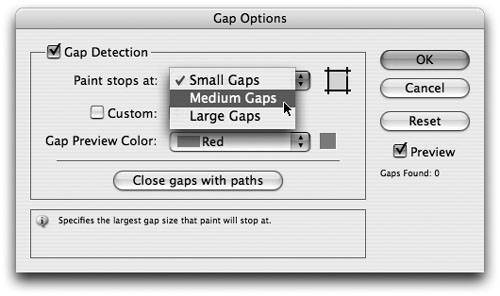 Gap OptionsWith Gap Detection turned on (Figure 4.50), you can specify that paint will fill areas that contain small, medium, or large gaps. Additionally, you can specify an exact amount for how big a gap can be before Live Paint considers it an open area instead of a closed one. Illustrator previews gaps in the selected color, and you can also choose to have Illustrator fill any gaps in an object with physical paths (Illustrator always uses straight paths to do so). Figure 4.50. With a Live Paint group selection, you can choose to open the Gap Options dialog from the Control palette. Releasing and Expanding Live Paint GroupsLive Paint groups can be expanded, at which time they behave like ordinary vector paths. The appearance of an expanded Live Paint group remains identical to the original, but it is split into multiple objects for both fills and strokes. This is similar in concept to expanding Live Effects. To expand a selected Live Paint group, either click the Expand button in the Control palette or choose Object > Live Paint > Expand.
From a production standpoint, there's no need to expand Live Paint groups in order to prepare a file for print. Live Paint groups print perfectly, because Illustrator performs the necessary expanding of paths at print time (similar to Live Effects). Additionally, you can choose Object > Live Paint > Release to return a Live Paint group to the original paths that were used to create it. Where expanding a Live Paint group results in objects being broken up in order to preserve appearance, releasing such a group preserves the geometry of the original paths, but the appearance or colors are lost. Using Live Paint to Edit PathsIf you think about it, Live Paint allows you to apply attributeslike fills and strokesto paths based on their appearance as opposed to their actual makeup. It would be even nicer if you could actually edit your paths based on appearance as well, don't you think? Adobe was apparently reading your mind (a scary thought) and added another tool to the mixthe Live Paint Selection toolwhich enables you to select portions of objects based on their appearance. Let's take a look at an example. Use the Line Segment tool to draw two perpendicular lines, creating an X. Select both paths and press Command-Opt-X (Ctrl-Alt-X) or choose Object > Live Paint > Make to convert the two paths into a Live Paint group. Now, choose the Live Paint Selection tool and click one of paths. You'll notice that each segment of the line can be selected individually. What were two paths before are now four line segments (Figure 4.51, next page). With one segment selected, press the Delete key to remove that segment from the path. Select another segment and change its stroke attribute (Figure 4.52, next page). You can also click one segment and then drag to select other segments in one step. Figure 4.51. Using the Live Paint Selection tool, you can select visual segments of a path. Figure 4.52. In a Live Paint group, you can easily apply different stroke attributes to the segments of a path. The Live Paint Selection tool can also select the fills of Live Paint areas. If you have two overlapping shapes in a Live Paint group, you can select the overlap and delete it (Figure 4.53). Figure 4.53. The Live Paint Selection tool enables you to select any area of a Live Paint group. At the end of the day, Live Paint adds a more flexible way to color and edit paths, and it also adds more value to the Pencil tool, because complete closed paths aren't required. The important thing to remember is that a Live Paint group is a group, and anything that you can do with a group in Illustrator you can do with Live Paint groups as well. For example, you can add attributes like strokes to the Live Paint group for interesting effects (Figure 4.54). Experimenting with the Live Paint feature certainly helps you when you're editing paths, and the good news is that it's a fun feature to use. Figure 4.54. Adding a stroke to a Live Paint group at the group level makes it possible to apply stroke attributes that appear only around areas that are filled. |
EAN: 2147483647
Pages: 147
